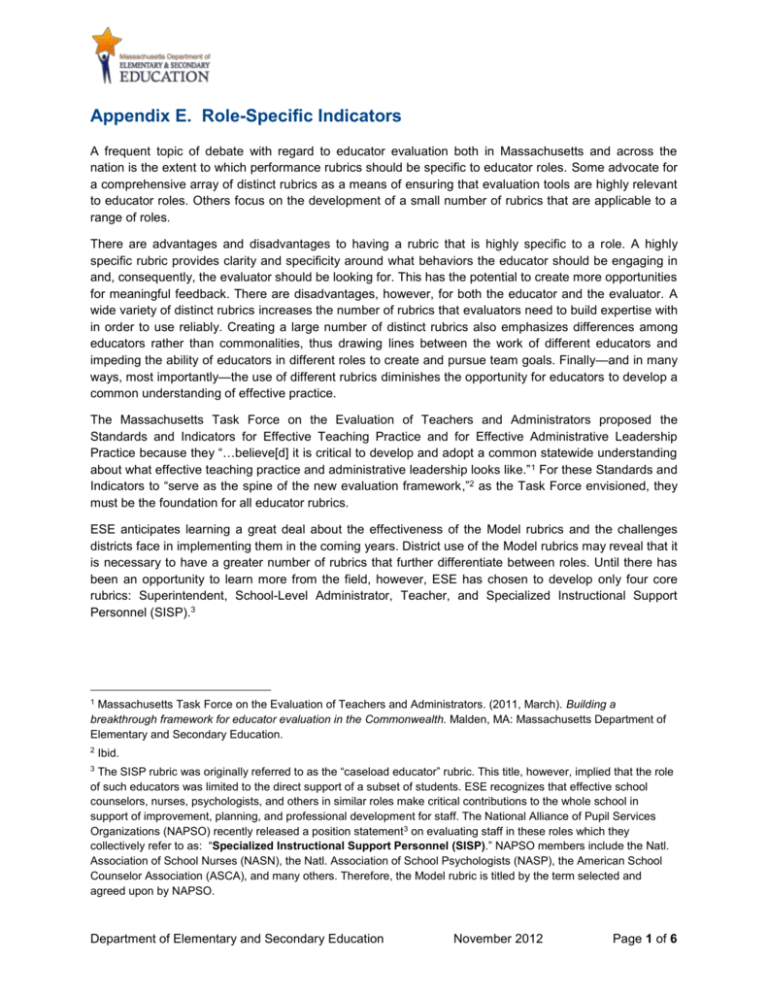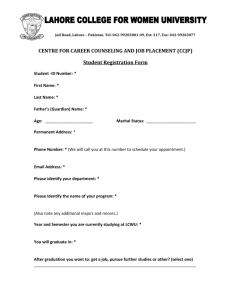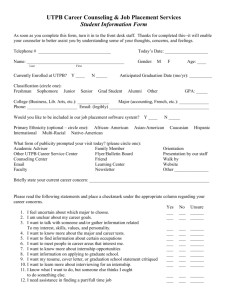ESE Part III Guide to Rubrics and Model Rubrics for Superintendent
advertisement

Appendix E. Role-Specific Indicators A frequent topic of debate with regard to educator evaluation both in Massachusetts and across the nation is the extent to which performance rubrics should be specific to educator roles. Some advocate for a comprehensive array of distinct rubrics as a means of ensuring that evaluation tools are highly relevant to educator roles. Others focus on the development of a small number of rubrics that are applicable to a range of roles. There are advantages and disadvantages to having a rubric that is highly specific to a role. A highly specific rubric provides clarity and specificity around what behaviors the educator should be engaging in and, consequently, the evaluator should be looking for. This has the potential to create more opportunities for meaningful feedback. There are disadvantages, however, for both the educator and the evaluator. A wide variety of distinct rubrics increases the number of rubrics that evaluators need to build expertise with in order to use reliably. Creating a large number of distinct rubrics also emphasizes differences among educators rather than commonalities, thus drawing lines between the work of different educators and impeding the ability of educators in different roles to create and pursue team goals. Finally—and in many ways, most importantly—the use of different rubrics diminishes the opportunity for educators to develop a common understanding of effective practice. The Massachusetts Task Force on the Evaluation of Teachers and Administrators proposed the Standards and Indicators for Effective Teaching Practice and for Effective Administrative Leadership Practice because they “…believe[d] it is critical to develop and adopt a common statewide understanding about what effective teaching practice and administrative leadership looks like.” 1 For these Standards and Indicators to “serve as the spine of the new evaluation framework,”2 as the Task Force envisioned, they must be the foundation for all educator rubrics. ESE anticipates learning a great deal about the effectiveness of the Model rubrics and the challenges districts face in implementing them in the coming years. District use of the Model rubrics may reveal that it is necessary to have a greater number of rubrics that further differentiate between roles. Until there has been an opportunity to learn more from the field, however, ESE has chosen to develop only four core rubrics: Superintendent, School-Level Administrator, Teacher, and Specialized Instructional Support Personnel (SISP).3 1 Massachusetts Task Force on the Evaluation of Teachers and Administrators. (2011, March). Building a breakthrough framework for educator evaluation in the Commonwealth. Malden, MA: Massachusetts Department of Elementary and Secondary Education. 2 Ibid. The SISP rubric was originally referred to as the “caseload educator” rubric. This title, however, implied that the role of such educators was limited to the direct support of a subset of students. ESE recognizes that effective school counselors, nurses, psychologists, and others in similar roles make critical contributions to the whole school in support of improvement, planning, and professional development for staff. The National Alliance of Pupil Services Organizations (NAPSO) recently released a position statement3 on evaluating staff in these roles which they collectively refer to as: “Specialized Instructional Support Personnel (SISP).” NAPSO members include the Natl. Association of School Nurses (NASN), the Natl. Association of School Psychologists (NASP), the American School Counselor Association (ASCA), and many others. Therefore, the Model rubric is titled by the term selected and agreed upon by NAPSO. 3 Department of Elementary and Secondary Education November 2012 Page 1 of 6 Role-Specific Indicators We recognize and appreciate that for any rubric to fulfill its intended purposes,4 some districts desire more specificity for the role. ESE staff members have worked with stakeholders to determine the need for strategic and balanced adaptations to the Model rubrics that would more precisely reflect the roles of certain educators and uphold the vision of the Commonwealth. In order to address this need for more specificity, we suggest that districts may want to consider developing “role-specific Indicators” that could be added to the Model rubrics. To provide assistance to districts interested in pursuing this option, ESE is partnering with state organizations who are leading the development of sample “role-specific Indicators” to serve as exemplars that can be used to supplement the Model rubrics.5 Implementing role-specific Indicators allows for evaluation to incorporate elements specific and possibly unique to a certain role. Using role-specific Indicators to supplement a “base” rubric such as the Specialized Instructional Support Personnel (SISP) rubric preserves that opportunity for specificity while simultaneously emphasizes commonalities across roles. In addition, the division between the “base” rubric and the role-specific Indicator(s) creates a structure through which it may be more feasible for evaluation to be shared by multiple evaluators. For example, principals are typically more qualified to assess a school nurse’s contributions to school culture than they are to evaluate the nurse’s clinical skills. In that situation, a principal may be the primary evaluator for the majority of the Standards on the Model SISP rubric while a head nurse or non-core supervisor/director might be a contributing evaluator with responsibility for assessing performance on role-specific Indicators specific to the school nurse. Role-specific Indicators may also be used to supplement a teacher or administrator rubric to illustrate specific responsibilities. For example, a district may want to develop a Coaching Indicator for teachers, administrators, or other specialists who spend a significant amount of time coaching other educators. Implementing Role-Specific Indicators If districts choose to incorporate role-specific Indicators into their evaluation process, each Indicator should be associated with a Standard defined in the regulations and considered when rating an educator’s performance against the respective Standard. If a district has chosen to supplement the Standards defined in the educator evaluation regulations with additional local standards, supplementary Indicators may fall under those local standards as well. In that case, performance on the supplementary role-specific Indicators should be considered when rating an educator’s overall performance. “Rubrics are designed to help educators and evaluators (1) develop a consistent, shared understanding of what proficient performance looks like in practice, (2) develop a common terminology and structure to organize evidence, and (3) make informed professional judgments about formative and summative performance ratings on each Standard and overall.” Massachusetts Department of Elementary and Secondary Education. (2012, January). Massachusetts model system for educator evaluation Part III: Guide to rubrics and model rubrics for superintendent, administrator, and teacher. Malden, MA: Massachusetts Department of Elementary and Secondary Education. 4 5 The role-specific Indicators developed in partnership with the organization are designed to fall under the Standards defined through the regulations, but the definition of these additional Indicators is not defined in the regulations. They are intended to be a local supplement and can be considered as part of an educator’s evaluation. Districts are not required to use role-specific Indicators. Department of Elementary and Secondary Education November 2012 Page 2 of 6 Example: School Counselor Indicators The School Counselor Indicators were developed in partnership with the Massachusetts School Counselor Association and are based on both state and national principles and standards for school counseling.6 In particular, it was developed to align with the Massachusetts Model for Comprehensive School Counseling.7 It is recommended that these Indicators be used in conjunction with the Model Specialized Instructional Support Personnel (SISP) rubric or a comparable rubric aligned with the Standards and Indicators defined in 603 CMR 35.03 (Standards and Indicators for Effective Teaching Practice). These Indicators are not intended to replace any of the Indicators in the SISP rubric. The Indicators are not taken from the regulations and are not a required component of the educator evaluation framework or the MA Model System for Educator Evaluation. The two additional Indicators specific to school counselors are structured as follows: Indicator I-D: Systemic Planning and Delivery aligns with Standard I and is further defined through three Elements: Strategic Planning for Systemic Delivery; School Counseling Curriculum; and Coherent Delivery. Indicator II-E: Student Services aligns with Standard II and is further defined through five Elements: Academic Advising; Transitions; Post-Secondary Planning; College Planning (if applicable, per professional judgment); and Responsive Services. Sample School Counselors Indicators are available at the conclusion of this Appendix. Additional Strategies Developing role-specific Indicators may not be the appropriate strategy for some educator roles. One alternative strategy is to adapt a Model rubric in small but strategic ways to better align performance descriptors to specific roles and responsibilities. The Massachusetts Association of School Business Officials (MASBO), for example, adapted the Superintendent Model Rubric to reflect the role of a school business administrator.8 ESE also encourages districts and organizations to consider developing resource documents in support of the Model Rubrics that identify role-specific educator behaviors and “look-for’s” aligned to the descriptions of practice in a Model rubric. ESE is committed to partnering with statewide organizations, including school psychologists and school nurses, to develop materials in line with these strategies to meet the needs of all educators. 6 Resources: The Massachusetts Model for Comprehensive School Counseling Programs; American School Counselor Association: School Counselor Competencies; West Virginia School Counselor Performance Rubrics; The College Board National Office for School Counseling Advocacy: Eight Components of College and Career Readiness Counseling. 7 http://www.doe.mass.edu/ssce/mscamodel.html ESE reviewed MASBO’s rubric to ensure it met regulatory requirements for comparable rigor and comprehensiveness. The MASBO rubric is available on its website here. 8 Department of Elementary and Secondary Education November 2012 Page 3 of 6 School Counselor Indicators Accompanies Standard I: Curriculum, Planning, and Assessment. Promotes the learning and growth of all students by providing high-quality and coherent instruction, designing and administering authentic and meaningful student assessments, analyzing student performance and growth data, using this data to improve instruction, providing students with constructive feedback on an ongoing basis, and continuously refining learning objectives. Indicator I-D. Systemic Planning and Delivery. Uses data to create a comprehensive school counseling program; develops and delivers a standards-based counseling curriculum; and promotes coherent delivery by fostering schoolwide involvement. Unsatisfactory Needs Improvement Proficient Exemplary I-D-1. Strategic Planning for Systemic Delivery Makes limited use of data in designing a plan for the delivery of a school counseling program; the plan is not systemic; and/or the plan does not include interventions designed to address inequities and close achievement gaps. May use some data to design a strategic plan for the systemic delivery of a school counseling program, but some aspects of the plan are not formulated with measurable outcomes or only minimally include interventions designed to address inequities and close achievement gaps. Using district/school data, designs a measurable, strategic plan for the systemic delivery of a comprehensive school counseling program, including targeted interventions designed to address inequities and close achievement gaps. Using national, district, and school data, collaborates with relevant staff to design a measurable, strategic plan for the systemic delivery of a comprehensive school counseling program, including targeted interventions designed to address inequities and close achievement gaps. Is able to model this element. I-D-2. School Counseling Curriculum Develops a counseling curriculum that is minimally aligned to standards and/or student needs; does not deliver a curriculum that addresses students’ academic/technical competencies, career/workplace readiness, and/or the personal/social skills necessary for success. Develops a standards-based counseling curriculum that aims to support some students to develop academic/technical competencies, career/workplace readiness, and the personal/social skills necessary for success but delivery is inconsistent and/or some students’ needs are not addressed. Develops and delivers a standards-based counseling curriculum that supports all students in developing academic/technical competencies, career/workplace readiness, and the personal/social skills necessary for success in higher education, the workplace, and other postsecondary options. Develops, delivers, and appropriately adjusts a standardsbased counseling curriculum that empowers all students to develop academic/technical competencies, career/workplace readiness, and the personal/social skills necessary for success in higher education, the workplace, and other postsecondary options. Is able to model this element. I-D-3. Coherent Delivery Makes little or no attempt to foster schoolwide involvement in the design, planning and/or advancement of the school counseling program. Makes limited attempts to foster schoolwide involvement in the design, planning and/or advancement of the school counseling program to ensure coherent delivery through the coordination of school counseling activities with academic curricula, classroom instruction, and services across grade levels. Fosters schoolwide involvement in the design, planning, and advancement of the school counseling program to ensure coherent delivery through the coordination of school counseling activities with academic curricula, classroom instruction, and services across grade levels. Leads schoolwide collaboration around the design, planning, advancement, and regular assessment of the school counseling program to ensure coherent delivery through school counseling activities that are coordinated with and inform academic curricula, classroom instruction, and services across grade levels. Is able to model this element. I-D. Elements Department of Elementary and Secondary Education April 2012 page 4 of 6 School Counselor Indicators Accompanies Standard II: Teaching All Students. Promotes the learning and growth of all students through instructional practices that establish high expectations, create a safe and effective classroom environment, and demonstrate cultural proficiency. Indicator II-E. Student Services. Helps all students become college and career ready through academic, career, and post-secondary planning and knowledge-building that promotes equity and access; provides responsive services and supports transitions to reduce barriers that impact student achievement. II-E. Elements Unsatisfactory Needs Improvement II-E-1. Academic Advising Academic planning and advising is only available to few students, support is not customized to meet the needs of all students, and/or advising is not delivered in a timely manner to support students to meet course, grade, graduation, or post-secondary requirements. Inconsistently contributes to a college and career ready culture within the school by occasionally providing activities or strategies to support students to prepare for, participate in, and succeed in rigorous academic programs; range of supports is limited and/or supports do not meet all students’ needs. Contributes to a college and career ready culture within the school by providing classroom activities, group counseling, or individual sessions that promote equity and access by supporting all students to prepare for, participate in, and succeed in rigorous academic programs. Facilitates a college and career ready culture within the school by providing a wide-range of effective activities, strategies, and interventions that promote equity and access through customized support for all students to prepare for, participate in, and succeed in rigorous academic programs. Is able to model this element. II-E -2. Transitions Rarely contributes to development, coordination and implementation of strategies for grade-to-grade, school-toschool and school-to-postsecondary transitions for students, or contributions are ineffective. Contributes to development and coordination of strategies for grade-to-grade, school-to-school and/or school-to-post-secondary transitions for some students, but implementation of transition strategies is incomplete. Contributes to development, coordination and implementation of effective strategies for gradeto-grade, school-to-school and school-to-post-secondary transitions for all students. Assesses the effectiveness of transition planning in positively impacting student achievement. Leads development, coordination and implementation of effective transitions for all students in collaboration with colleagues, administrators, families, higher education institutes, and/or workforce development specialists. Is able to model this element. II-E-3. Post-Secondary Planning Provides students with limited or no exposure to postsecondary options; provides minimal feedback on students’ post-secondary plans; and/or ineffectively or rarely utilizes career assessment techniques to assist students in identifying career abilities and interests. Provide some students with exposure to a limited variety of post-secondary options; provides occasional feedback on some students’ post-secondary plans; and inconsistently utilizes career assessment techniques to assist students in identifying career abilities and interests. Provides all students with timely exposure to a wide range of postsecondary options; regularly provides feedback on all students’ post-secondary plans; and utilizes various career assessment techniques to assist students in understanding and developing their career abilities and interests. Creates engaging opportunities that successfully lead all students to consider a wide range of postsecondary options; regularly provides feedback on all students’ post-secondary plans; and utilizes various career assessment techniques to assist students in understanding and developing their career abilities and interests. Is able to model this element. Department of Elementary and Secondary Education Proficient April 2012 Exemplary page 5 of 6 School Counselor Indicators II-E. Elements Unsatisfactory Needs Improvement II-E-4. College Planning If applicable9 Provides minimal or ineffective assistance in understanding the college and career application and admissions processes; rarely includes information about college costs, financial aid, scholarships and/or internship/apprenticeship processes and opportunities. Provides some assistance in understanding the college and career application and admissions processes, but may not support all students, and/or the range of information about college costs, financial aid, scholarships and/or internship/apprenticeship processes and opportunities is limited or not provided in a timely fashion. Provides timely assistance to all students in understanding the college and career application and admissions processes, including information about college costs, financial aid, scholarships, and/or internship/apprenticeship processes and opportunities. Provides timely and ongoing assistance to all students in navigating and completing the college and career application and admissions processes; supports students in addressing college costs with assistance in applying for financial aid and scholarships, grants, or other funding sources. Proactively connects students with internship/ apprenticeship opportunities. Is able to model this element. II-E-5. Responsive Services Rarely uses evidence-based counseling theories and techniques or relies on outdated practices to deliver short term counseling interventions to resolve immediate conflicts/problems, intervene in school-specific situations that disrupt learning, and/or respond to crisis events. Delivers short term counseling interventions to resolve immediate conflicts/problems, intervenes in school-specific situations that disrupt learning, and/or responds to crisis events, but the counseling interventions may not be evidence-based and/or utilized in all situations. Seeks out and implements evidence-based counseling theories and techniques to deliver short term counseling interventions to resolve immediate conflicts/problems, intervene in school-specific situations that disrupt learning, and respond to crisis events. Assesses the effectiveness of interventions and responses in positively impacting student achievement. Seeks out, implements, and continuously refines evidencebased counseling theories and techniques to deliver short term counseling interventions, intervene in school-specific situations that disrupt learning, and respond to crisis events. Collaborates with colleagues, administrators, and families in assessing the effectiveness of interventions and responses in positively impacting student achievement. Is able to model this element. Proficient Exemplary The school counselor and evaluator should discuss whether or not this Element is applicable to the counselor’s role at the beginning of the evaluation cycle and decide if it will be included as part of the counselor’s evaluation prior to implementing the Educator Plan. 9 Department of Elementary and Secondary Education April 2012 page 6 of 6








